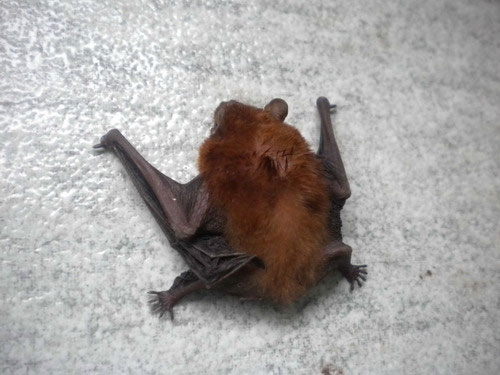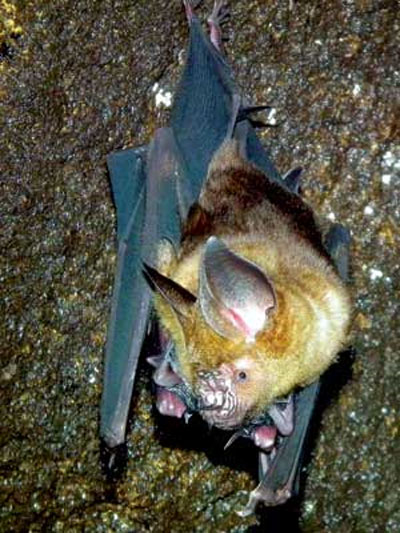Giants between mosquito bats
Referring to mosquito bats, we often envision small creatures that fit in the palm of our hand. However, if you encounter the bat-nosed nose bat, many people will be surprised because they are not small at all.
>>> How do vampire bats suck blood from their prey?
Radar can fly
The raven-nosed bat has a scientific name, the Hipposideros armiger ( Hodgson , 1835). Different from the majority of species in the hipposideridae family in particular and the mosquito bat group in general, crow's nose-billed bat has a huge size: wingspan of about 0.45m, weight of 37 - 51g.
This is a species with wide distribution, stretching from Nepal to Taiwan. In Vietnam, scientists have recorded this species in Ha Tinh, Quang Binh, Lam Dong, Ninh Thuan, Binh Thuan, Dong Nai .

Tylonycteris pachypus , which holds the record for the smallest mammal in Vietnam.
Similar to their little brothers, crow nose-nosed bats have the ability to fly and locate by ultrasound very well thanks to the highly developed nasal leaf structure . The nasal leaf structure in this species is quite complicated with intermediate structures and four side nasal folds on both sides of the muzzle.
The nasal lobe lobes in order from the forehead include: anterior frontal horseshoe (horseshoe-shaped), posterior leaf, middle leaf, anterior leaf, medial pad, auxiliary nasal leaf. The frequency of ultrasound that this species uses to locate fluctuates around 78kHz.

After being born, the bat often clings to the mother's bat to breastfeed.
dark Knight
Although the size is larger than the majority of other mosquito bats, the main food of the raven-nosed bat is still small insects such as termites, moths and some types of beetles. inhabiting caves into small groups of several dozen individuals. Occasionally, nose-nosed bats can share their 'home' with several other bat species.
When the sun has just set, bat crows the nose and fly out of the shelter, but does not go immediately to look for water puddles to ' refresh ' , then rush into the night, hunting for favorite insects. . Breeding season of this species lasts from April to July. After mating, bat moms often split the flock and fly to another cave, away from the male bats full of fleas to 'sink'.
Usually, each mother bats only gives birth to a baby bat. After birth, the mother bats take care of the baby bat continuously for three to four days. When the bat can attach itself to the cave ceiling, the mother bat will fly out to feed, but it will only hang around the cave to bring the baby bat back. After about five months, baby bats can find their own .

The hippocampus Hipposideros armiger (left) has a much larger body than the same type.
Raven-nosed bats are very useful species, they are natural enemies of many harmful insects for agriculture. According to calculations by scientists, a raven-nosed bat every night consumes as much as 3/4 of its body weight. A pack of bats of about 50 each year can kill nearly 700kg of insects. In addition, feces of this bat species contain a lot of trace minerals, very good for fertilizing plants .
Super small record
If the mammals in Vietnam organize the competition to see which species are the smallest size, the meat-bearing bat will win the championship. The name is like that because the fingers and the feet of this bat carry flat meat, and their scientific name is Tylonycteris pachypus (Temminck, 1840). They are very small, weighing no more than 2g, their skulls are very flat and thin: their skulls are not more than 2.5mm thick, keeping the smallest skull record among Vietnamese mammals.
Padded meat bats have the ability to fly and locate by ultrasound very well (the frequency of ultrasound that this species uses at about 60kHz). Scientists have recorded this bat in many localities such as Lai Chau, Lao Cai, Kon Tum, Nghe An, Lam Dong, Ninh Thuan, Binh Thuan, Dong Nai . During the day, while the species Bigger bats have to struggle to find caves, trees or hollows to hang up to sleep and sleep, meat-biting bats thanks to their small size and 'super-flat' skulls, which can fit into the gaps of the trees. bamboo and bamboo tubes in the forest.
Bitter leg bats often sleep together in small groups about five or seven. When the sun has just set, the flesh-and-blood bat leaves the warm bamboo tube house to fly to feast. Thanks to the skill of catching insects extremely well, every night a leg-shaped bat consumes an amount of insects equal to 3/4 of its body weight.
- Record new bats in Vietnam
- Legend of the two-headed giant
- Using mosquito bats and insecticides at the same time can cause explosion
- Build houses for bats to fight mosquitoes
- How do bats spread disease globally?
- Discover new bats on dogs in Panama and Ecuador
- Terrible hot sun causes bats to fall like a fig in Australia
- Discover panda bat in South Sudan
- The reason for mosquito repellent is spiral, you will not expect ...
- 7 misconceptions about mosquito prevention: It turns out that citronella cultivation can be counterproductive
- Discover 4 strange bat species
- New discoveries about bats: Male bats use food to propose
 Animal 'suffering' after hibernation
Animal 'suffering' after hibernation Why do goats climb well?
Why do goats climb well? Scientists were surprised to see chimpanzees eating turtles
Scientists were surprised to see chimpanzees eating turtles Giant catfish died deadly due to drought in Thailand
Giant catfish died deadly due to drought in Thailand Photographer captured an impressive photo: Dozens of starfish gather to eat sea lions
Photographer captured an impressive photo: Dozens of starfish gather to eat sea lions  Bats thought to be extinct reappear after 4 decades
Bats thought to be extinct reappear after 4 decades  Specter bats specialize in cannibalism
Specter bats specialize in cannibalism  'Batman' has appeared in ancient Mayan legends and is served as a god
'Batman' has appeared in ancient Mayan legends and is served as a god  Discover a rare and precious conifer population in Lao Cai
Discover a rare and precious conifer population in Lao Cai  Africa's most bizarre fox: Cute to beat but even hunted newspapers
Africa's most bizarre fox: Cute to beat but even hunted newspapers 